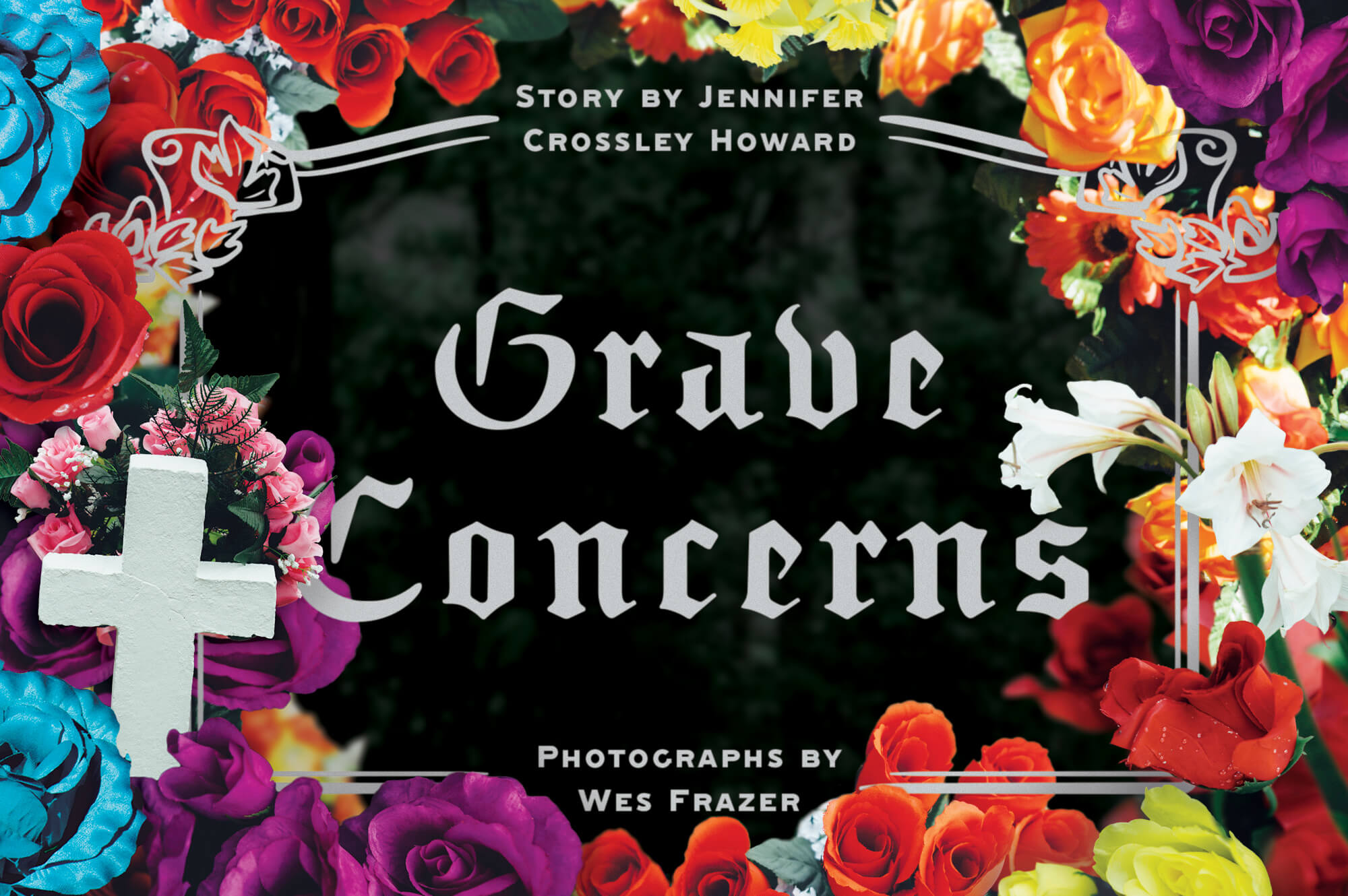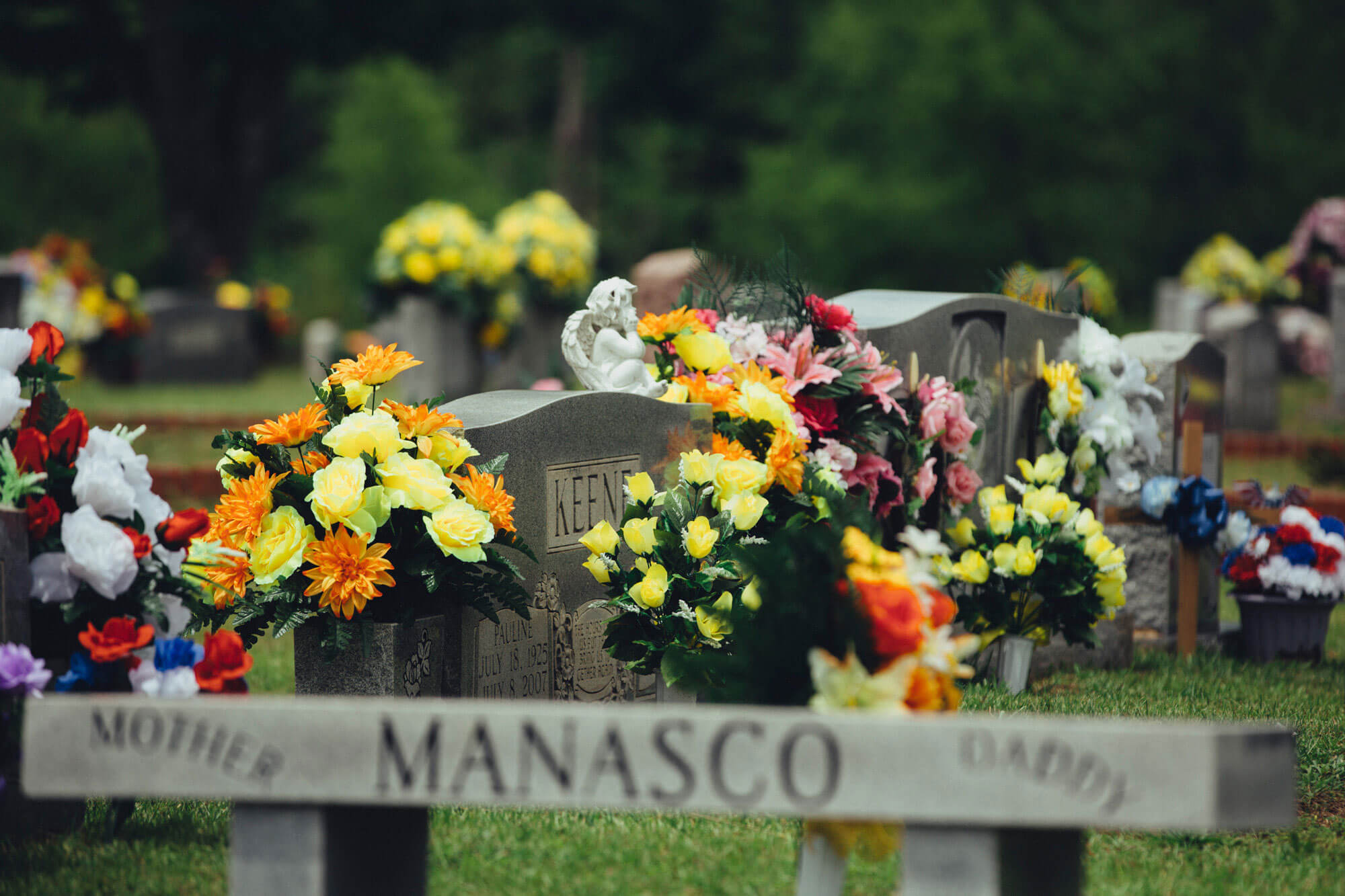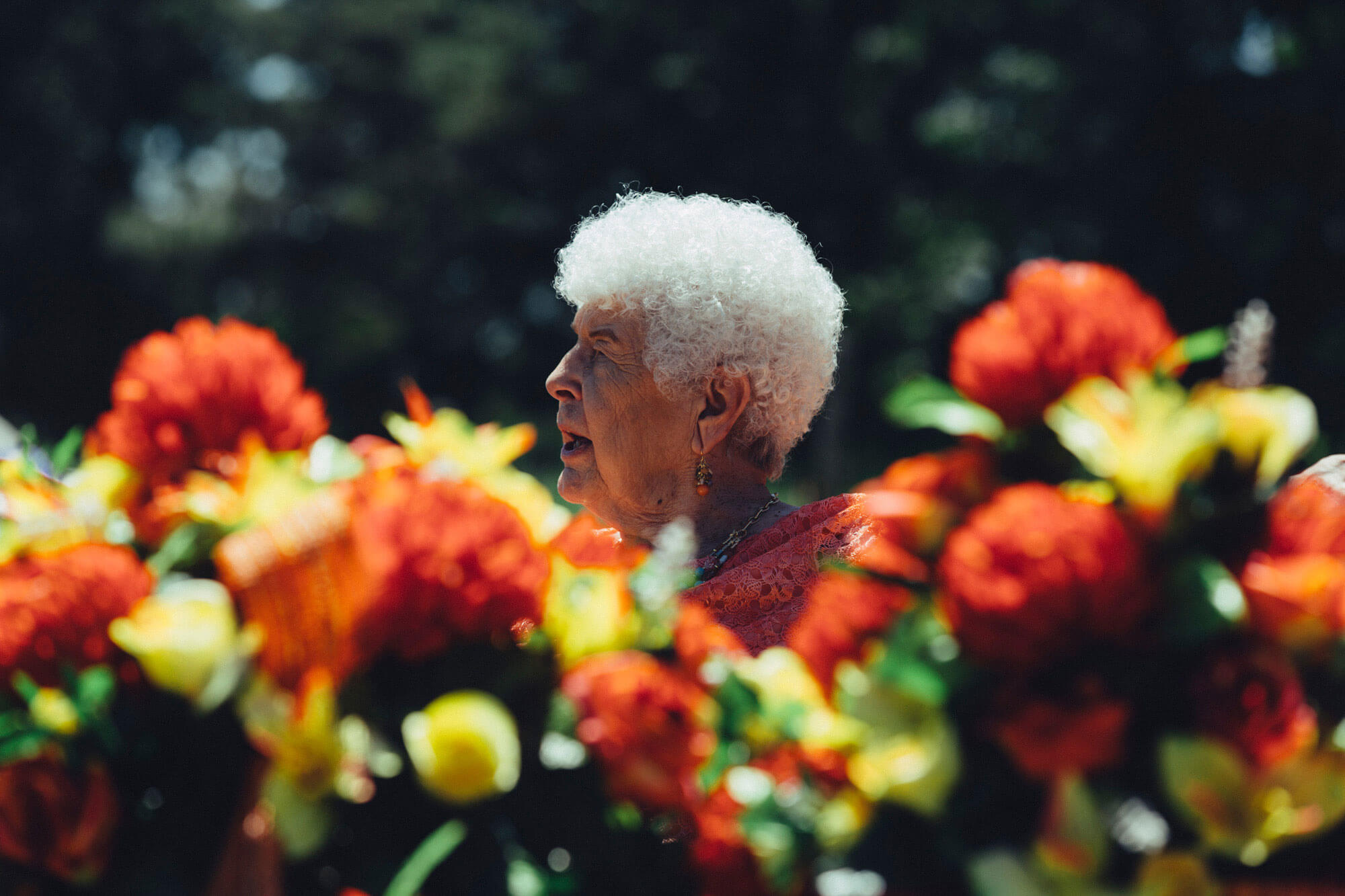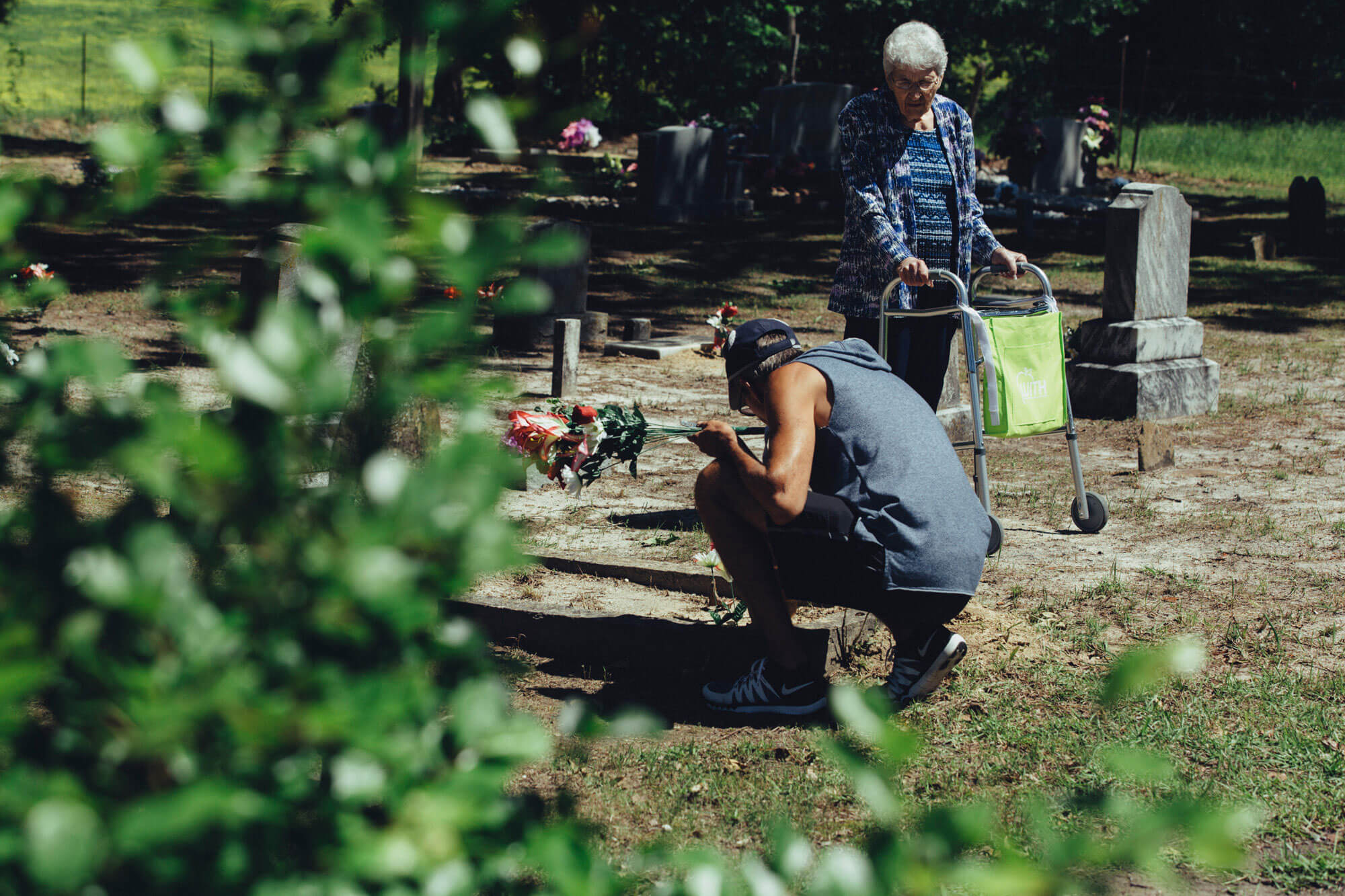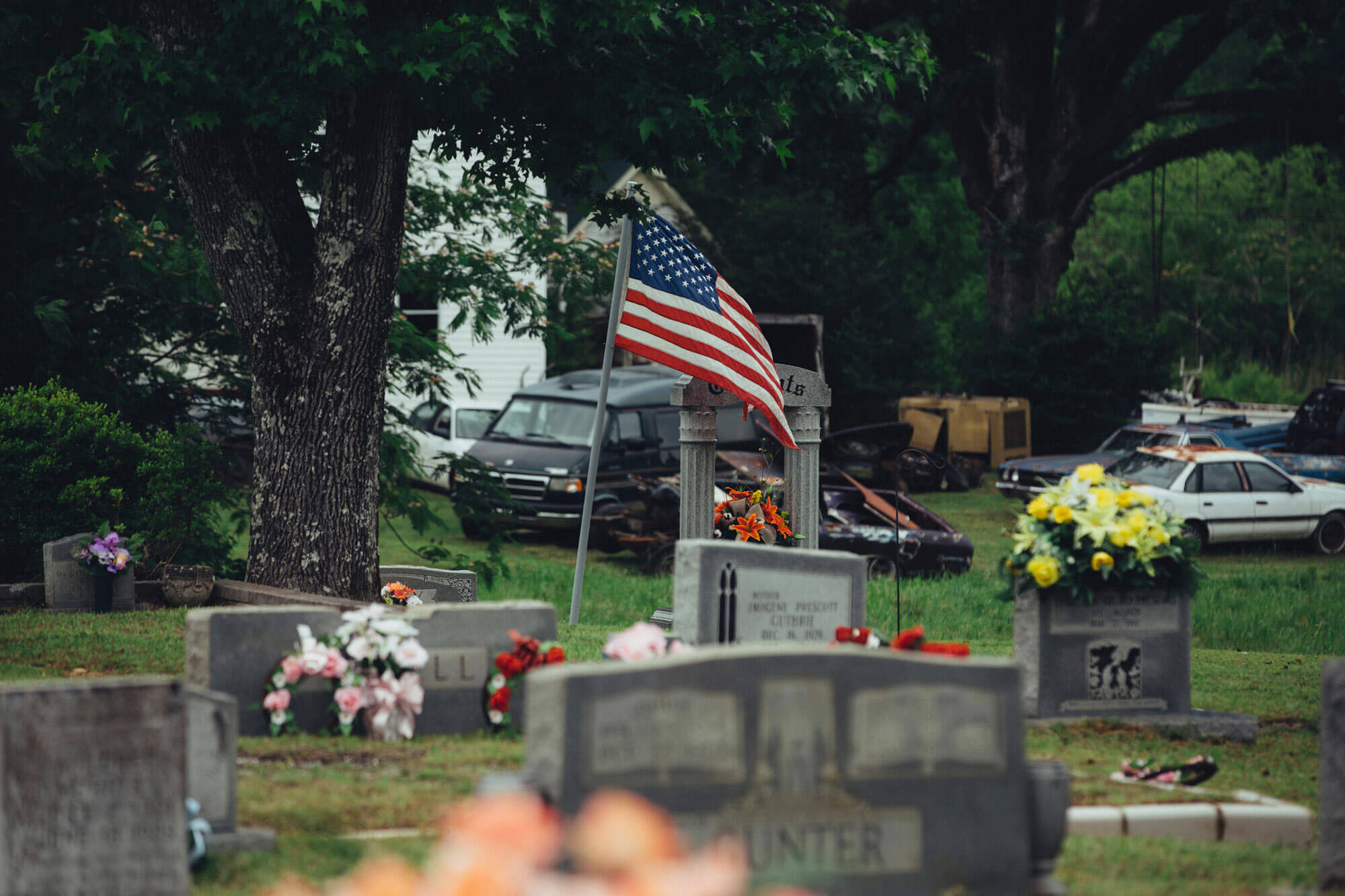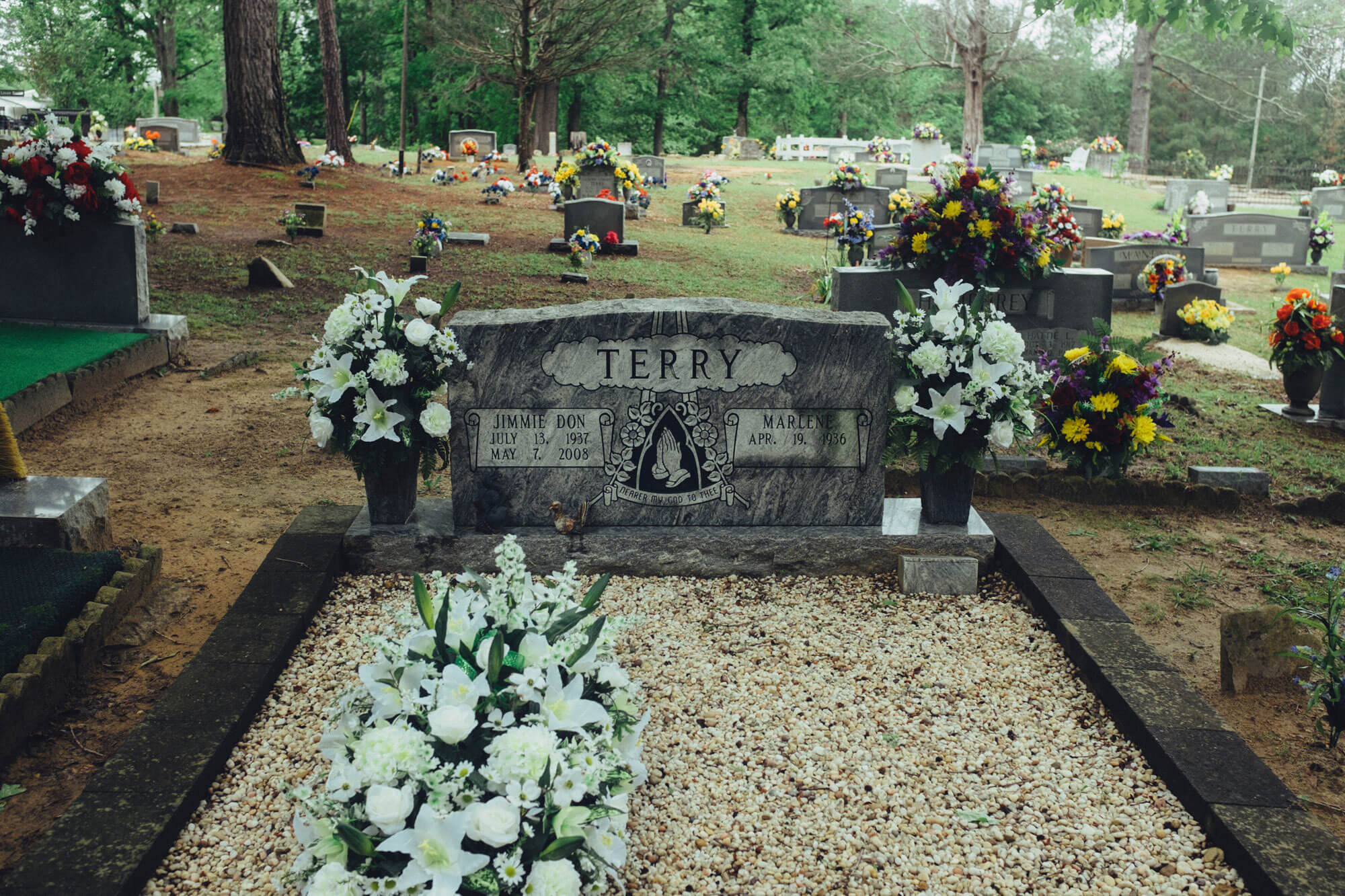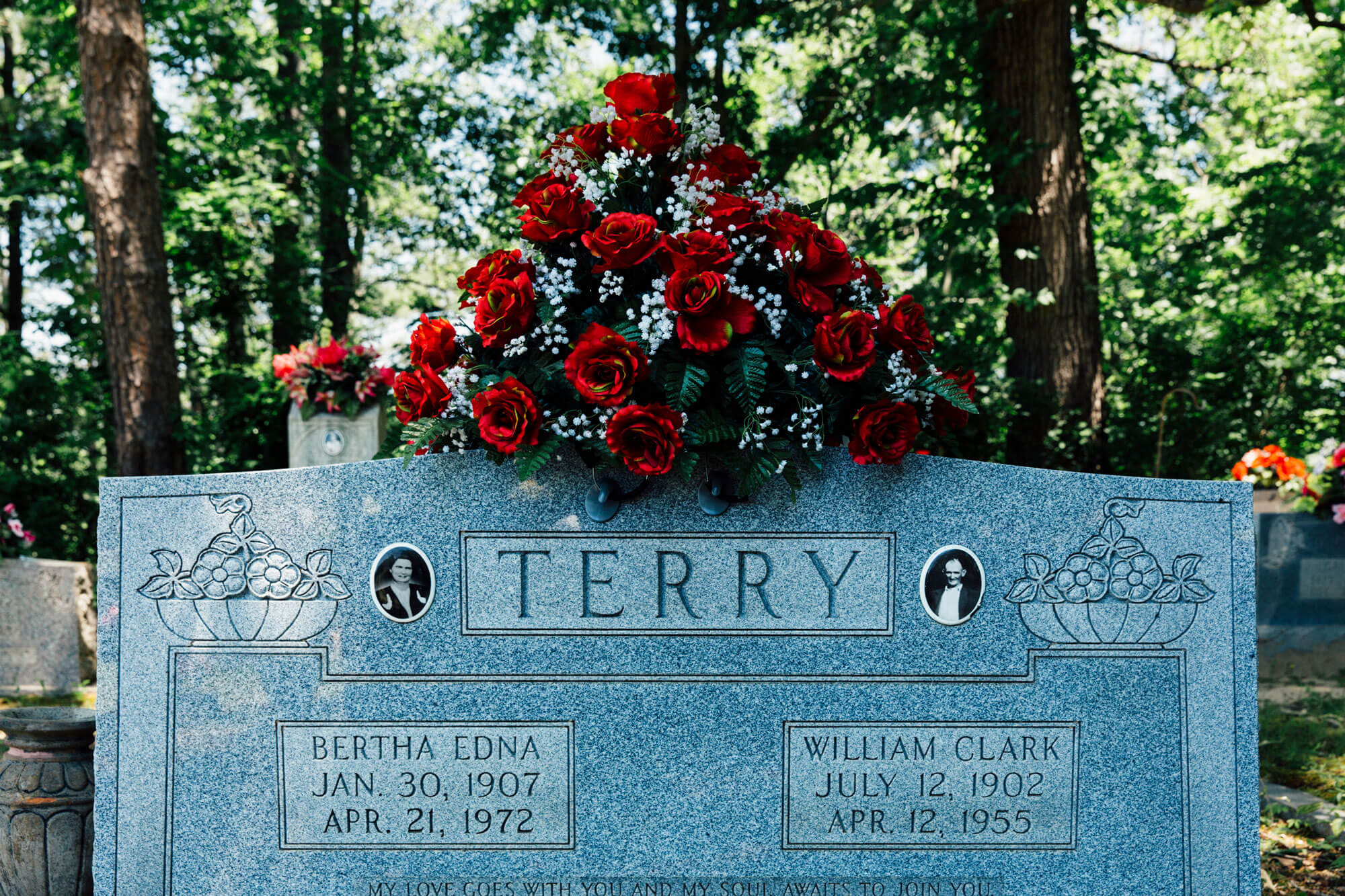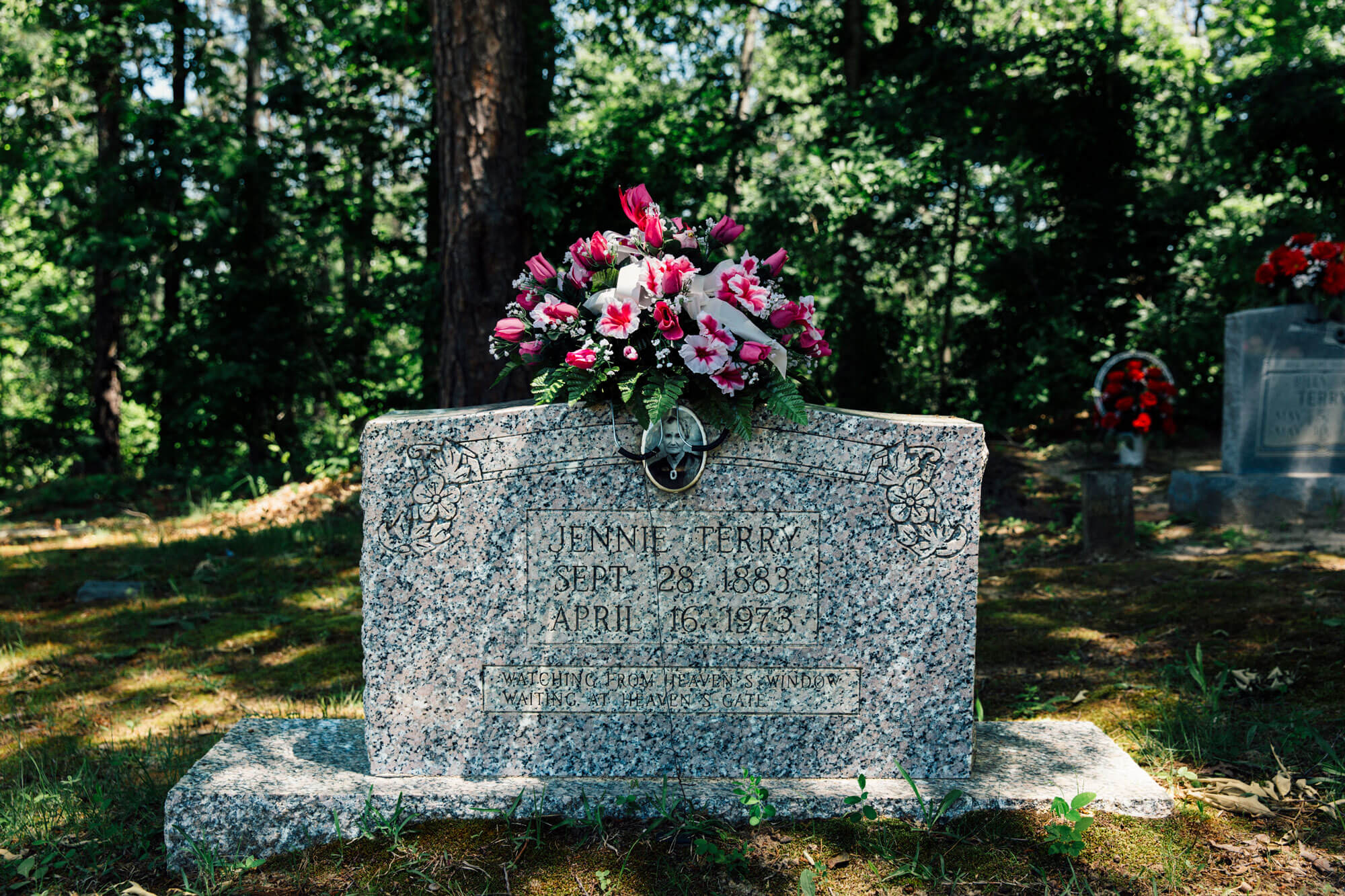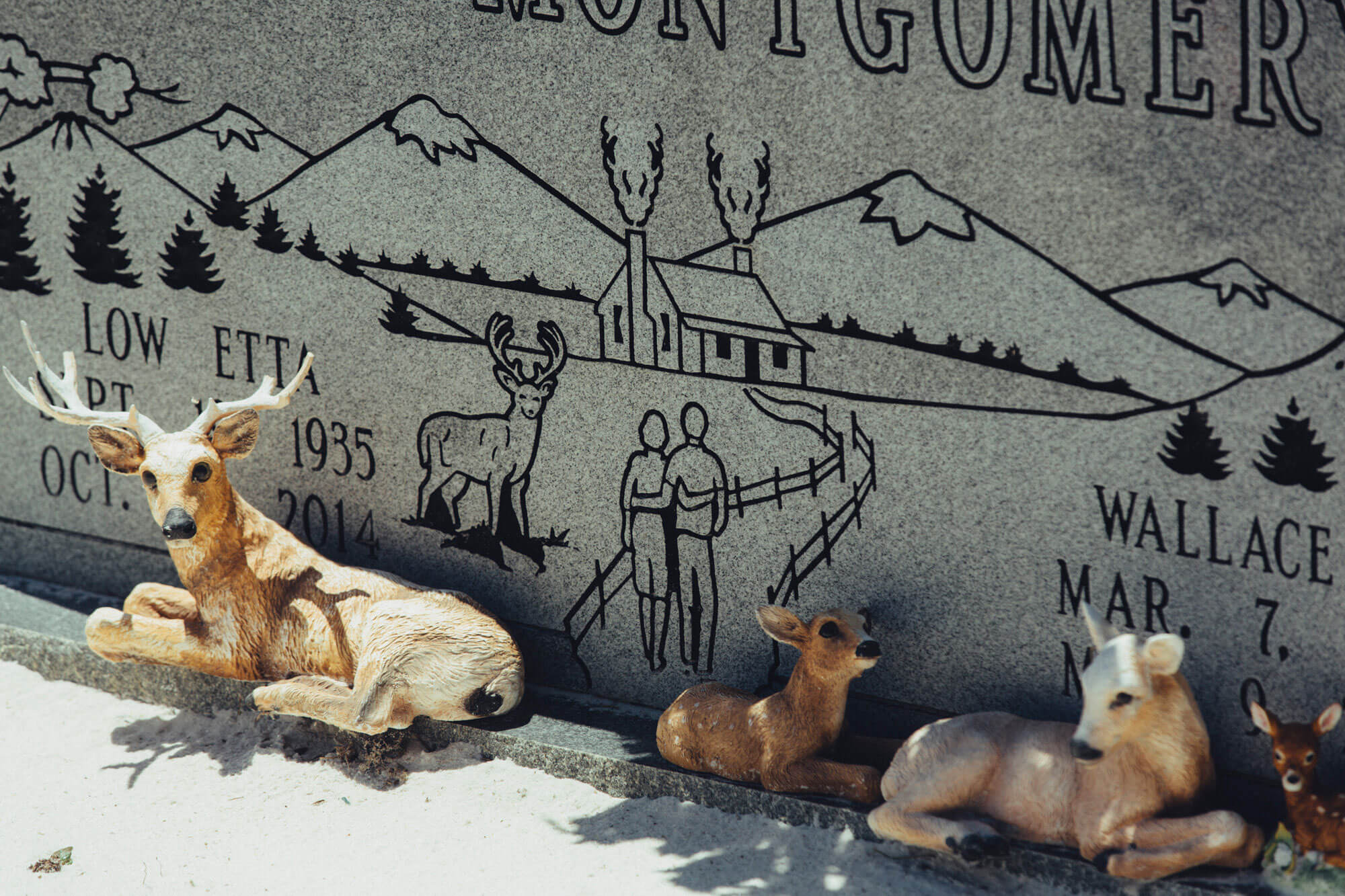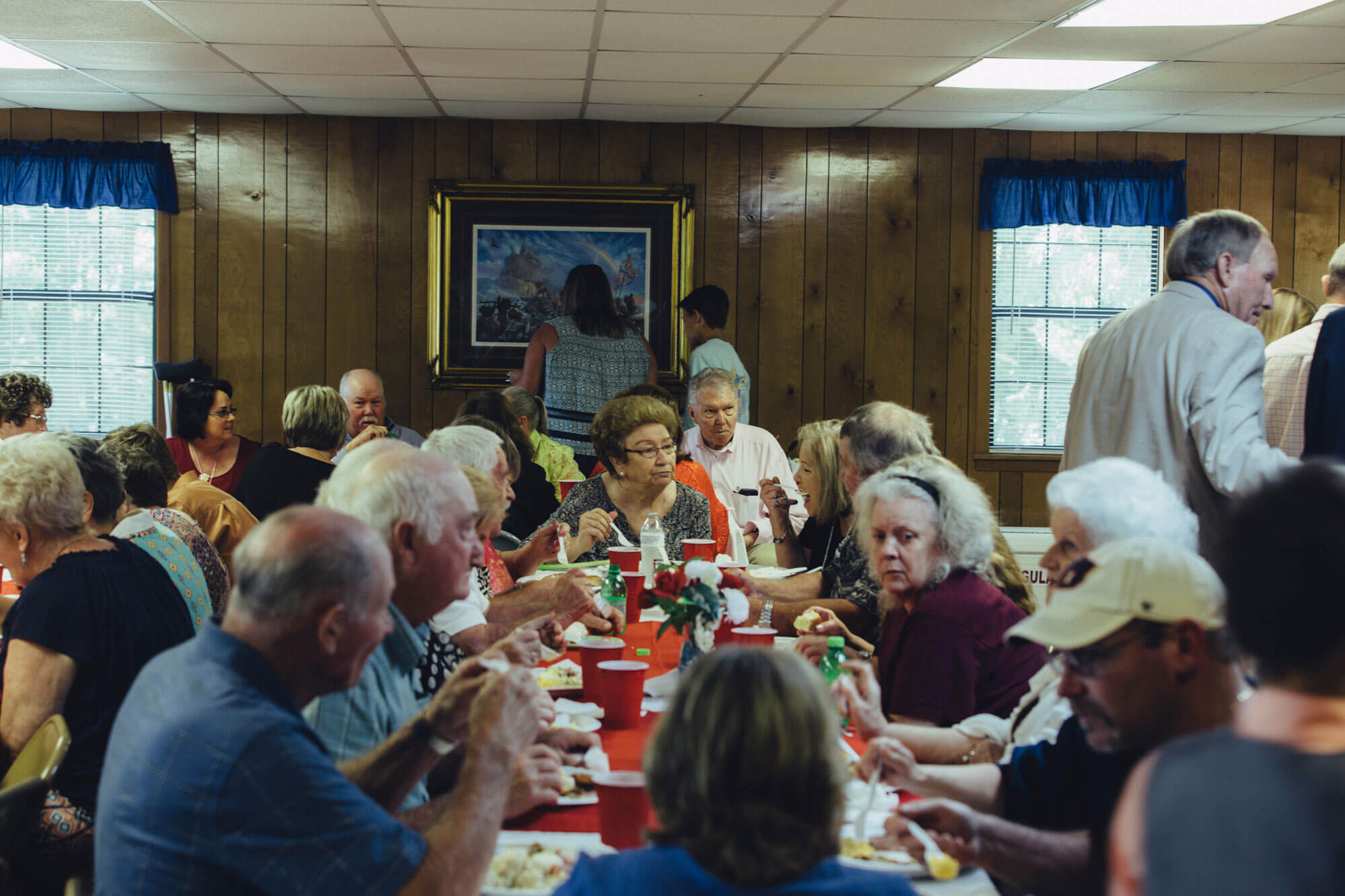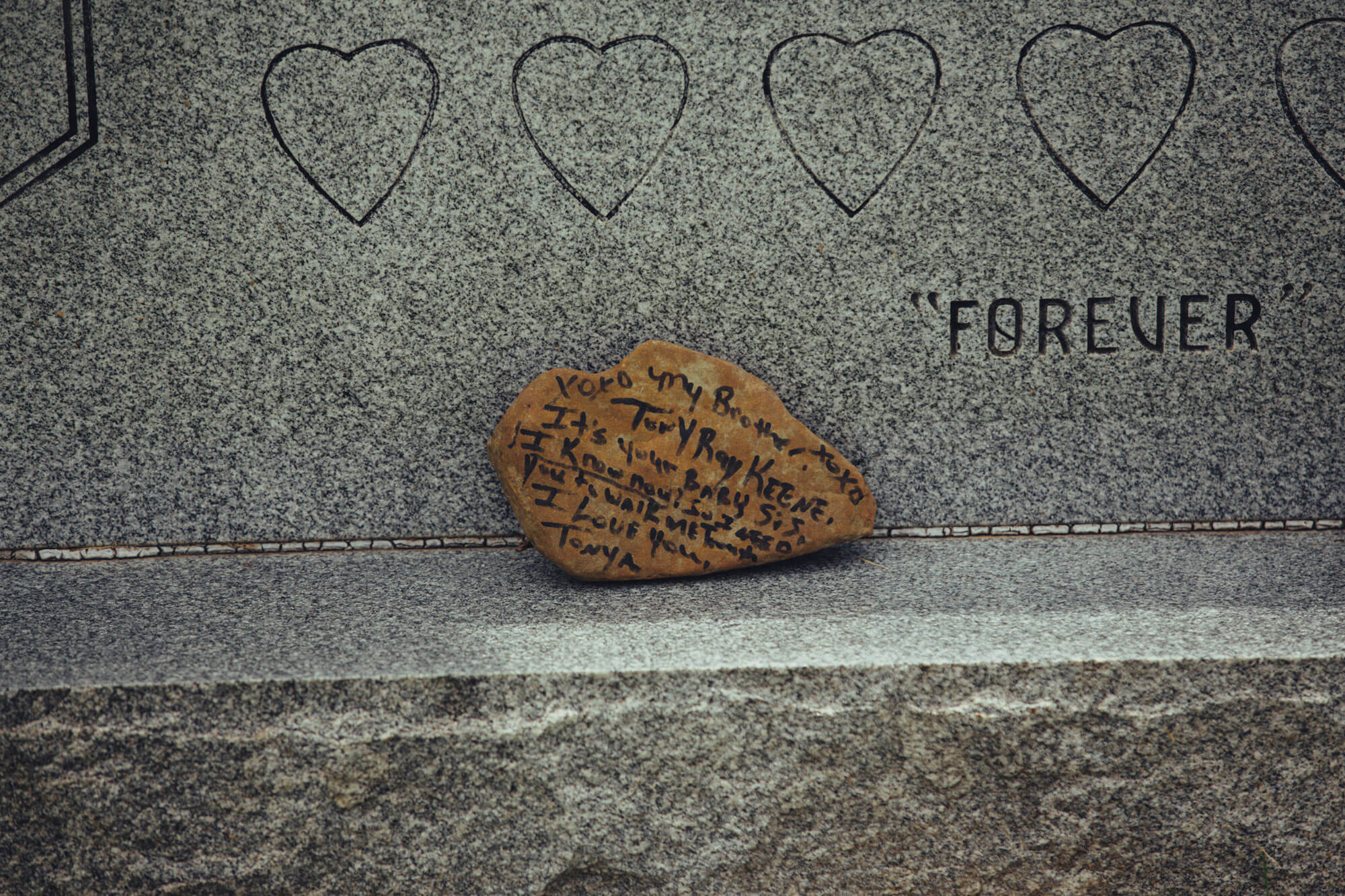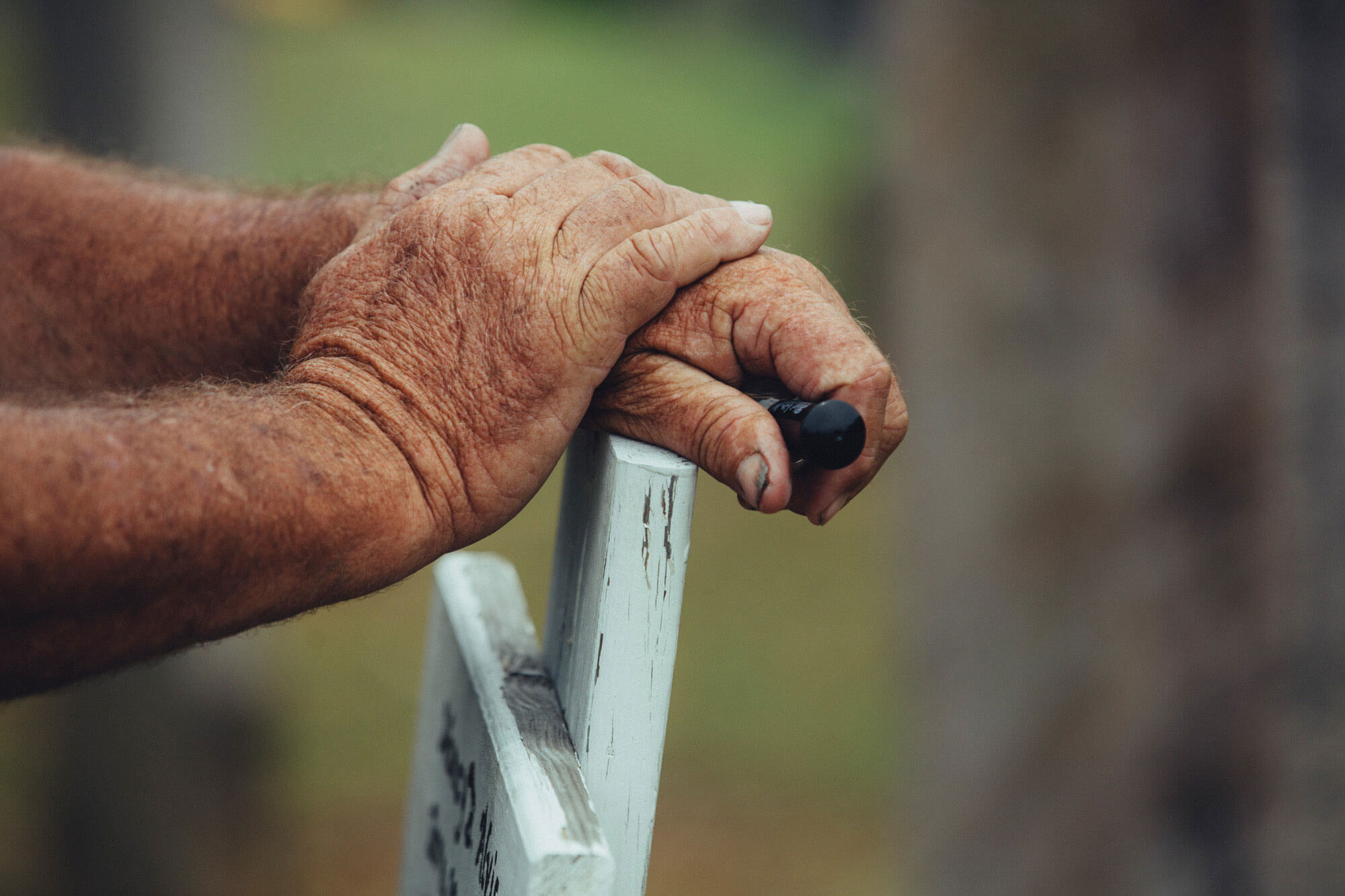They call it Decoration Day. It’s a uniquely Southern tradition — and a unique expression of our region’s fascination with death. Come along with us to North Alabama to eat and to remember — right there among the family gravestones.
Story by Jennifer Crossley Howard | Photographs by Wes Frazer
Brandy Sparks sneaks outside to puff a cigarette and avoid cleanup in the fellowship hall. She and a dozen other women have spent the last three days scrubbing, dusting and vacuuming Old Liberty Congregational Christian Church for this weekend. She puts on white sunglasses and steps down into the graveyard that nearly swallows this humble brick church in Lawrence County, Alabama. She points out a mother and daughter joint grave (died in 1868) that church congregants identified last year after months of research. She thinks the child was an infant because the unmarked slab is so small.
That child and her relatives by death and blood sleep across the narrow road from a pasture so green it almost glows in the May sun. Families huddle under oaks and cedars placing flowers on tombstones. Others have settled next to markers in lawn chairs shielding themselves with umbrellas.
There are too many people here for a church homecoming, and it’s too hot to be Easter Sunday. Today, we are here to eat, remember, and bask in the Southern fascination of death that is as sure as the first hellfire sermon that made you quake in the pews.
It’s Decoration Day.
Brandy Sparks has a cherry tattoo behind her ear and wears a plastic necklace.
When I approach her supervising the potluck lunch, she waves her hand. “I’m opinionated,” she says. “You don’t want to talk to me.”
Sparks began attending Old Liberty a year ago when her kids acted in the Christmas play, but she’s been going to Decoration Day since she was 8 years old in 1985. That’s the year her grandmother died.
“That first one was hard because most of my family is out there,” she says.
Dwelling in a cemetery can feel as natural as walking through a park or like a cruel reminder of the unavoidable. Sparks’ mother, Charlotte Gillespie, says the day eases the pain and loss of death.
“I used to visit daddy’s grave at 11 at night,” Gillespie says. “I’m completely comfortable about it. That’s life, I mean.”
The South claims death with as much loyalty as we claim our children. Lest we forget that this all will come to an end some day, each spring we pass cemeteries so bright they would shame an Impressionist painter. Sugarcoating gets a bad rap, but if anyone has found a way to soften the great blow of death, it is Southerners. To die is to trade up to a celestial world that never ends. We own death so it does not own us. You don’t title a novel “As I Lay Dying,” as William Faulkner did, because it sounds sweet or catchy. Death is simply something we all will do.
J.T. Lowery, a former pastor and “roundabout member” at Old Liberty, misses when Decoration Day meant keeping company with headstones during dinner on the ground.
“We’re spoiled by air conditioning now,” he says. Moving festivities inside, “it’s a little more sanitary than it is outside.”
Outside is where Opal Flannigan remembers riding up in her parents’ wagon as a little girl. She drove here from Florence to honor her mother, father, and great-nephew, whose headstones she sat among in a chair with the comfort of a concert goer or movie watcher. She is in her 80s, and she has come to this cemetery each spring since she was 3 weeks old. Even when she and her husband lived in Michigan for 13 years, they came home for Decoration Day. As a child, Flannigan walked the perimeter of the cemetery this day ringing handbells.
“At the end, we had prayer,” she says.
Back then, Decoration Day required meticulous, ritual-like preparation. Her family ate fried chicken and vegetables on the grounds of the cemetery on starched white, embroidered tablecloths. The night before, Flannigan would sit at the kitchen table with her mother twisting crepe paper into roses and mums. They moistened the paper and pinched it, bundling homemade stems together with wire. They made more than 100 flowers at a time.
“Give me the roses while I live and not after I’m dead and gone,” her mother told her as they worked.
Flannigan fears Decoration Day will fade away though her nieces and nephews give her hope.
“The next generations might pick right up,” she says. “You don’t know.”
Her own peace of mind is secondary for coming here.
“You ought to come here for your family,” Flannigan says. “It’s for honoring them. We know they’re not in their graves.”
Flannigan is depending on women such as Sparks to uphold a tradition so old it’s hard to say when it emerged.
“It’s very folk, very grassroots,” says Joey Brackner, Director of Alabama Center for Traditional Culture in Montgomery. “It’s like a big kind of community reunion.”
He attends four Decoration Days each year in two counties.
German and Scots-Irish immigrants who birthed much of the Southern Appalachia’s culture in Virginia, Tennessee, and the Carolinas likely brought these traditions, he added, and combined them with a region already steeped in a love of land, food, and religion. We have good company in European Catholics, whose celebrations of All Saints Day vary but often involve decorating graves, and Mexicans, whose Dia de los Muertos could be an artsier, darker, raucous version of All Saints Day.
“It’s one of those things people in other parts of the country don’t know about and don’t understand,” Brackner says.
At Old Liberty, Felicia Liles started helping her parents organize Decoration Day two years ago after her mother fell ill. She rented a dumpster this year to rid old flowers from graves, most of which are left from Christmas. Silk flowers can last for months with acrylic spray, enduring 101-degree heat and ice storms or whatever sort of tantrum the weather wants to throw. Liles is 47 and has been coming here since she was 18. This place is as much a reunion for the living as it is for remembering the dead.
“We have relatives here today from Illinois, and the only time they come is on Decoration Day because they have relatives buried here,” she says.
It’s late afternoon, and inside Old Liberty’s small sanctuary, a gospel quartet is finishing up. A singing is the cherry on top of any Decoration Day, late in the afternoon after socializing and lunch.
The group, dressed in suits and ties with a chartered bus waiting outside, sang about the end of the world, when all Christians will break free from their graves and meet in the sky as one believing body.
“Preachers keep preaching and singers keep singing because it won’t be long as it has been, I’ll tell you that,” one member told the crowd of 20.
Head to the Deep South or to a black church and mention of Decoration Day will often draw a blank stare. The tradition is very much white, and it gained prominence during the Civil War when most African-Americans were slaves and few, if any, had the means to fund a church, let alone a graveyard.
“It’s not really much of an African-American thing at all,” Brackner says. “Now, African-American churches will have kind of homecoming about coming back to church they grew up in with food and singing.”
Decoration Day and its themes of food and family spilled over to present-day celebrations such as “poundings” and hundred-year church anniversaries common at many smaller Southern churches.
Alabama’s Decoration Days are concentrated in Tuscaloosa County and across Walker, Winston, Cullman, and Lawrence counties, according to Brackner. Significant numbers of churches in Jefferson, Lauderdale, and Colbert counties celebrate as well.
“If you drive (Highway) 278 from Gadsden to Hamilton straight across east to west on Mother’s Day weekend, you will see more flowers on cemeteries than you can imagine,” Brackner says.
Recognition swelled during the Civil War as families visited cemeteries often to remember fallen soldiers. In Lawrence County, home to Harmony United Methodist Church and Old Liberty, each church has adhered to the same Sunday for decades to accommodate families attending multiple celebrations. And it’s a good thing, Brandy Sparks says, because most everyone scattered across the county is related in some way. Especially if you’re a Terry.
It is unseasonably cold this morning and rainy just enough to wet the red clay that paves the uphill entrance to Harmony United Methodist Church. The church sits a few miles from the center of the town of Courtland, which may have more churches than people to fill their pews. In early April, Courtland is a shady, green reminder that traditions die hard until they fade like the still, rusted boxcars standing on one set of the tracks that envelop this tiny town.
Yet, Norfolk Southern trains amble around the town square every hour, it seems. The International Paper mill closed here in 2014, and many of its employees — some 1,100 — left to find work. There are white Greek Revival homes with wrought-iron fences and pristine wicker sitting on wide porches. A neglected cousin sits two blocks away on cinderblocks refusing to give in to time. It is the kind of broken, forgotten house that even the haints eschew.
Harmony United Methodist has 60 members, and almost all of them are Terrys and are kin to each other by blood, marriage or both.
“If they’re not Terrys, they married a Terry,” says Jane Terry.
A concrete angel and pair of brass crosses greet worshippers at the entrance. Inside, members and visitors — around 90 people — mill around looking at paraphernalia chronicling the church’s origins. There are yellowed photo albums, faded framed pictures, and envelopes of Christmas pageant pictures from the 1990s. There was talk at lunch of a little girl who almost got switched for walking on these graves the day before.
Pastor Darrell Mosley preached his hour-long sermon on Decoration Day. He was shocked that no one in his congregation had ever engaged in shape-note singing.
“Not even the older crowd?” he wondered.
“Sadly, it’s kind of a dying tradition,” he says later, a statement that could apply to both shape-note singing and Decoration Days.
“The younger ones are not quite as into it as our grandmothers and great-grandmothers were,” he says. ”When I walk through that cemetery, probably 20 to 30 people have died in the last 24 years. It’s like a walk down memory lane.”
Outside, up another hill on the sodden, moss-covered earth is an Auburn football birdhouse, a framed photo of a smiling elderly lady, and graves enclosed in squares of river rock and pebbles. A man by the name of “Fishhook,” aka Auburn Terry, grins from his picture embossed on a smooth granite headstone. He’s wearing his tan fishing vest.
Pat Guice, who is 72 years old, attends a local Baptist church but has attended Decoration Day here since 1944. She played piano here for 33 years and was married in the simple wood-beamed sanctuary. She says she started playing piano after she got saved when she was 11 years old in August of 1956. There was a revival at the old church building, a mile up the road. Decoration Day is as much of a holiday as any other for her.
“Some young people think it’s out of style, but I think it’s important,” Guice says. “The people who have passed away need to be remembered at least once a year.”
Out back in the graveyard, silk flowers stand out against dirt and concrete, but the mood turns cheery. This is the South where politics and religion mix as well as gin and tonic.
A handful of members, including Mosley, stand shivering in the wind talking. Talk covers disgraced former Alabama Gov. Robert Bentley, then the presidential election. This corner of northwest Alabama holds perhaps the last pocket of a rare species, Yellow Dog Democrats. The crowd recalls how former Democratic Alabama Gov. Don Siegelman retreated here a few miles away.
Lora Dyar told Mosley, “Vote for the person, not the party.”
“I see Roy’s toes sticking out of the grave now,” Mosley replied, referring to her father six feet below.
Yet not everyone handles death so well as a Baptist from birth or a faithful Methodist. Flowers have gone missing from the Old Liberty graves, caretakers had to drill concrete angels into the ground, and bullet marks pock a 6-foot granite monument to veterans at Pocahontas Methodist Cemetery in Carbon Hill, Alabama.
David Manasco carefully applied clear nail polish to camouflage the dings. The monument stood five years pristine before someone took a BB gun to it.
“It’s just pitiful people do that,” Manasco says. “I’ve asked people around who they saw, but no one’s seen anything.”
A grave digger by trade, Manasco started taking care of this cemetery after a local woman took pictures of its neglect, and the Daily Mountain Eagle published them. He cuts grass around graves four to six times a year and surveys things. His son helps and will take over when Manasco is no longer able. He sits the better part of two days under a green tent the fourth weekend each May, taking donations for his work.
Cutting so many acres is expensive — often $200 each time, he says. He remembers when 500 people attended Decoration Day here. A train races behind the cemetery, adding a wistful soundtrack to a sticky, overcast day. For all the vibrant silk flowers that adorn most graves, some visitors tote baskets of real periwinkles and petunias. The Butler and McCurry families on the edge of the cemetery like to show off a bit each year, splurging on eight full, bright sprays of silk roses and several mixed silk baskets. Pocahontas is a free cemetery. You can claim a plot here, but if someone else needs it first, it’s theirs.
Across the narrow road is a perpetual care cemetery, a centralized means to pay for labor and upkeep through a trust. Most cemeteries that still host Decorations Days are owned and overseen by churches, or they pay for outside labor. Regardless of the type of cemetery, it is up to families to place and discard flowers most of the time.
“As time goes on, cemeteries have become businesses,” says Joey Brackin, the Alabama historian.
His father is buried in a commercial cemetery in Birmingham.
“They bought those graves with the understanding their graves would always be cared for,” he says.
Danny Hill, who lives a mile away from Pocahontas Cemetery in Carbon Hill, has come here every year since he was born in 1963.
Then, a single Baptist church served this cemetery. The simple, one-story, brick building also served as the school in the 1930s. Carbon Hill, a town of 2,000, once thrived with farming and mining, but meth and strip mining have contributed to its downfall, Hill says.
Both sets of his grandparents, his father, aunt, uncle, and several friends are buried here.
“David’s took over and done a good job with it,” Hill says. “I believe it will last a while. But when he’s gone, I don’t know.”
Manasco’s son Ryan, a 24-year-old who oversees his father’s grave digging business, has it in his blood to take over.
“He’s just that type of person,” Manasco says.
My great-grandmother and great-grandfather on my father’s side are buried near the new church built on the other end of the cemetery, near the scrap yard. Queen Ann Boshell grew up poorer than dirt, but her mother gave her riches through a royal name. It runs in the family. Her father, after all, was named Andrew Jackson Boshell. She and William Toxey Nesmith had 11 children in Carbon Hill, and my grandmother, Dorothy Crossley, is the last one living.
Her sister, Ivory Bridgmon, hosted Decoration Day here for years. I remember the celebrations I attended when I was in high school and college best because of the heat, casseroles, and jokes. After visiting the cemetery, we’d drive back to Ivory’s house, which was so covered with flowers you could barely see the front porch. To the side of the house were three tables set up with fried chicken, sides, and desserts. Ivory died in December, and though I will miss her bold proclamations — “he’s as pale as cotton” and “lordy, lordy” — it is these gone gatherings that pain my heart most.
If you’re not from around here, Decoration Day sounds morbid. It is centered around death, a word which many find impossible to even utter let alone comprehend.
Yet, I witnessed not one tear at these celebrations, though I witnessed plenty of laughter. Just like bitter tea, Southerners take death and heap a lot of sugar on it and serve it in a myriad of palpable ways. Coconut cake, chocolate cupcakes in Halloween wrappers and banana pudding all made the last stop at Old Liberty’s 20-foot-long potluck dinner table in the fellowship hall. If there’s another thing Southerners do well, it’s laugh at themselves. At the Key Underwood Coon Dog Memorial Graveyard south of Muscle Shoals, a mock Decoration Day for the beloved hunting companions buried there takes place each Labor Day.
“There’s a big feast, bluegrass music,” Brackin says. “It just shows you how strong the idea is.”
Levity aside, Decoration Day reminds us that though this life ends, we must live with verve.
The lichen-covered tombstone of N.E. Alvis, born 1843 and died in 1904, puts it best:
“Remember friends, as you pass by, as you are now so once was I, and as I am now soon you will be.”

